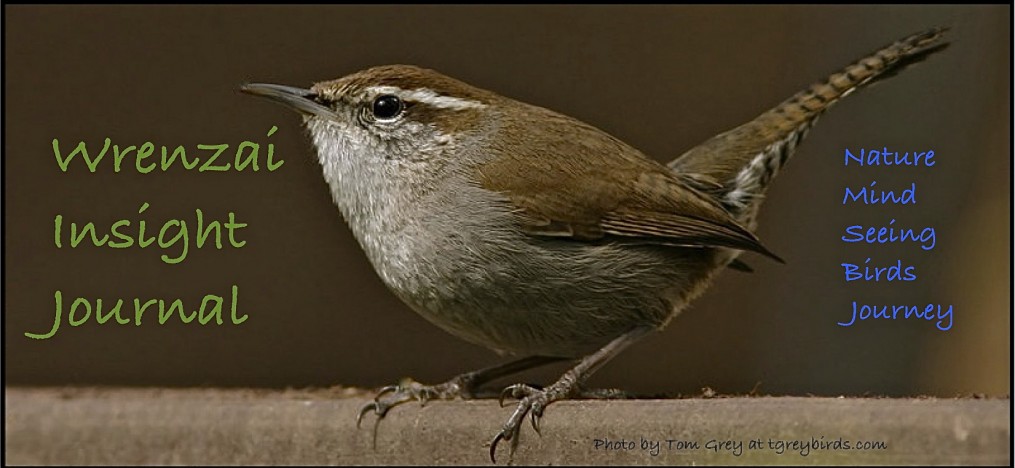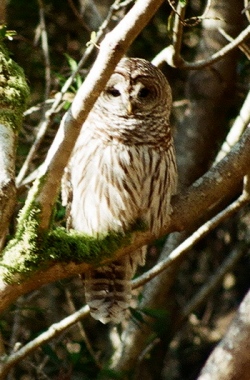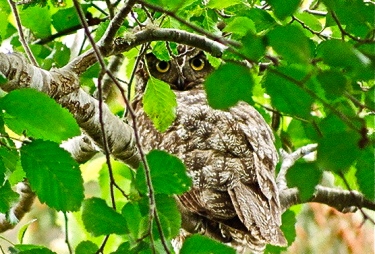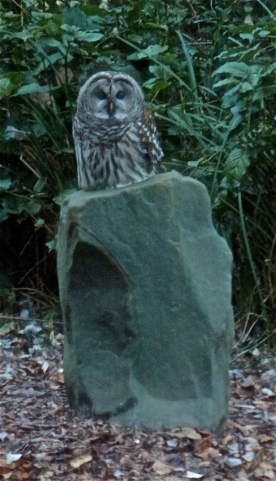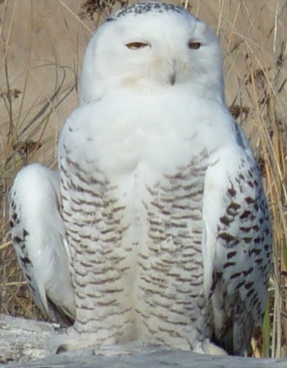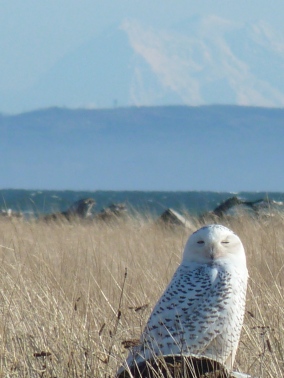I am no less under the thrall of owls than were the Ancients, no less than are the New Agers and Halloween Trick or Treaters of modern times. More than any other bird, they perch motionlessly, or near motionlessly, on a limb near the house and peer at the ground below for rodents or the unwitting small bird. Or they raise their eyes to peer at me, unblinking and unfazed, or so it would appear.
First to impress her power and stamina upon me was a barred owl. She arrived one Sunday morning and took as her launch a myrtle limb from whence she kept an eye peeled for a rat that regularly made the journey to and from our railroad-tie compost box. All day the owl watched—and I watched her, checking to see if she’d snagged that sneaky rat. Interestingly, I was all for the owl, not being fond of rats visiting my compost box, let alone our house. But she still hadn’t left her post by the time we packed up to return to the city.
When we arrived the next weekend, I hurried straight from the car over to the limb where she’d waited so patiently, and sure enough there was a bolus of rat bones and fur below the limb and a large splat of white shit on the limb. Apparently, she’d not only had more patience for the rat to appear than the rat had for her to disappear but she’d also had the extra patience to digest it right where she’d slain and ate it.
Then, because owls have a way of appearing out of nowhere then disappearing for months on end, I didn’t see or hear an owl for nearly a year till one early morning I heard crows cawing scoldingly and robins chirping angrily from the time I woke till sunset that day. Here’s the story, in a simple narrative poem:
Great Horned Owl
Crows, cawing,
wake me up early.
I shut the window,
go back to sleep.
Crows, cawing, make me
close the sliding glass door
as we eat our breakfast
and drink our coffee.
Maybe there’s an eagle perched
in the spruce, out of sight.
Maybe it’s just a young crow
who’s over-flown its boundaries.
Maybe it’s a murder,
a congregation or congress
of crows. But the robins are chirping too:
Maybe the crows have found a robin’s nest!
I step outside, sidle roundabout into the woods
till I stand beneath the spruce, look up,
see an enormous owl with ears,
perched unfazed on a low thick limb.
Chickadees, towhees, a solo wren
have joined in the melee
at their respective elevations
in the crabapple tree below.
The owl has seen me, stares at me hard,
and as he does is caught off guard
by a charging crow and flaps
over to a limb on the alder tree.
And there, all day,
crows and sometimes robins
yell and swoop at what I now identify
as a Great Horned Owl.
I watch it blink its wide yellow eyes,
its pupils contract amidst sunlit leaves.
The big bird stares at me but never flinches,
impervious to the flak from other birds.
Only night will get those crows
off that poor owl’s back, when crows
return to their regular roost and the owl
starts hunting in the dark
for rats and shrews,
perhaps a sleeping crow,
though tonight this owl will have to hunt
without a good day’s snooze.
My mother died on July 5th, 2011. On the eve of what would have been her 81st birthday, lo and behold a barred owl landed and perched till after dark on the three-man stone my father and I—he with a broken collar bone and I with tendonitis and bursitis in a shoulder joint—in other words with two arms between the two of us—hauled up from the beach and set on a mound on the south side of the house as, what turned out for me, a memorial to my mother that I’ve come to call the Mother Stone—or the Mom-olith. I’ve heard many stories about birds appearing at moments of death, funerals, and memorials. Now when I look at that shapely green stone, not only can I not help but think of my mother but also can I not help but re-envision that barred owl perched there so long that evening, looking at me. The next day, her birthday, Fran picked flowers that I placed on top of the stone, I said a few words, and then I spread a small urn of her ashes that my father had prepared for me for the occasion, around the base of the stone.
Then, during the winters of 2011-12 and 2012-13, we had major “irruptions” of snowy owls from the arctic tundra to the wide-open grassy areas of Protection Point. The first year, there were seven owls, the second year eight. They stayed from November to April, hunting for and devouring any small rodent that resembled their main prey in the arctic, the lemming. Theory has it that the older, bigger owls force these younger owls out of their birthright feeding grounds due to increasing numbers of owls and therefore decreased numbers of lemmings. So the younger birds fly south in search of similar hunting grounds. They perch on the drift logs stranded up in the grass and doze during the day in plain sight, making them a much-sought-out photographic subject. Tens of thousands of photographers, tourists, and nature pilgrims have worn whole systems of new trails through those tundra-like meadows. Fran and I were amongst those many seekers of an owl sighting. As many as eight times each year, we took yogis, photographers, birders, friends, family, and the “bird-curious” out toward the end of that long sand-accreted point. What great, weighty, mythical birds snowy owls are! Here are a couple poems inspired by their mystery and magnificence:
Snowy Owl
I do not want to make you
any wiser than you are.
But to stop and stare,
astonished by your size,
your snowy elegance,
your golden blinking eyes
(with what solidity
you perch upon a snag
overlooking winter seas!)
is to experience the love
of timelessness, to join
the wise in motionlessness
and mute austerity.
I bask in seeing and being seen by you,
being ransacked of all my pretensions
by your otherworldly purity
and penetrating gaze.
I stand for minutes richer than hours,
minutes enriching, adding to, my years.
I clothe myself in your downy feathers,
I breathe in the coolness of your soul,
I don the precious gems of your eyes
and through you see myself, as animal.
On strong wide wings you veer away
as I glide back down the beach,
clad in my new white robe,
the whole world glittering gold.
Birders Flock
How reassured I feel
in a world where I find myself
standing amidst a whole flock
of birders, their giant lenses,
like tremendous beaks,
mounted on stork’s legs
of tripods, zooming in on
a single sleepy snowy owl
perched unimpressed
on a dune-grass drift-log,
their cameras chirping away,
clacking countless photos,
mesmerized for hours
in finger-freezing weather.
Now this gives me hope.
Owl’s, because they’re often huge, have large eyes, and can appear human and wise, and because they generally hunt and hoot at night and seem to show up at auspicious times, are said to be mysterious, prophetic, meaningful birds. Owls were sacred to the Greek goddess of learning, Athena, as a symbol of status, intelligence, and wealth. For the Egyptians, Celtics, and Hindus, owls were guardians of the underworld, protectors of the dead, rulers of the night, seer of souls. Owls have been honored as keepers of spirits who have passed from one plane to another, accompanying spirits to the underworld. As a result, owls have acquired a negative association with death (images of owls are a common sight at Halloween time, or All Souls Day). For Americans First Peoples, they were associated with wisdom and foresight and were keepers of sacred knowledge and forecasters of the weather. West African and Aboriginal Australian cultures saw the owl as a messenger of secrets, kin to sorcerers, mystics, and medicine people. In medieval Europe, they were thought to be priestesses and wizards in disguise. Their appearance announced change or death (or a life change). In general, they helped see that which was hidden from the view of others.
Interestingly, I never quite feel the same when I’m in the presence of an owl. Owls have abilities that far exceed any I can boast of: They can fly, of course, and can fly so stealthily that they cannot be heard by the unsuspecting small critter. They can see at night better than I can see during the day, and they are infinitely more patient than I am in their work to satisfy their needs. It’s this patience that sustains an owl’s life, a generally overlooked example I strive to emulate.
